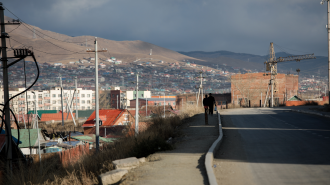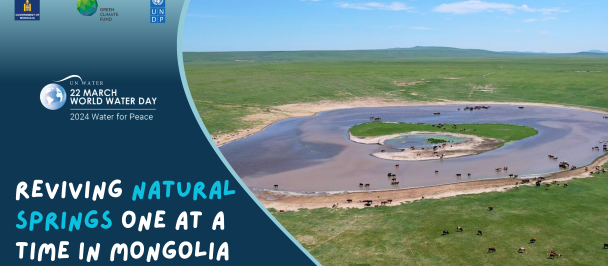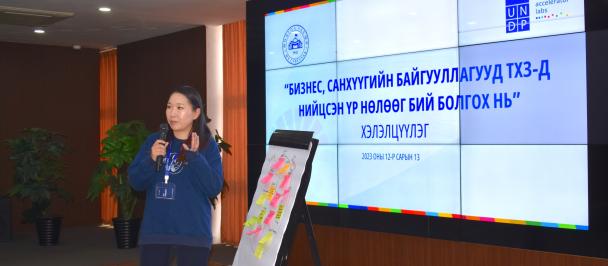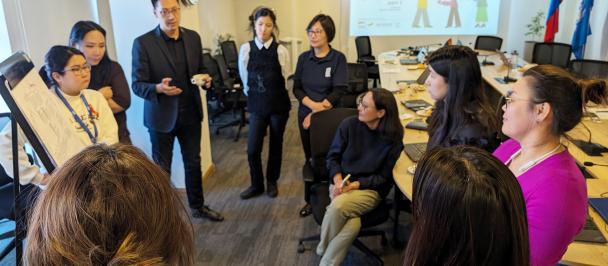Rising above adversity: A Mongolian Woman’s Journey to Decent Life
November 1, 2023
Mongolia is one of the least dense countries in the world with only two people per square kilometers. However, close to 51 percent of its 3.4 million people are living in the capital Ulaanbaatar, which barely makes up 0.03 percent of the total land, drastically increasing the density of the city.
Consequently, city is extremely overpopulated facing numerous infrastructure challenges which has profound impact on the livelihood of its residents. While the downtown area filled with high rises and hustle and bustle of any metropolis might tempt you to believe life is all well, the outlook changes drastically in the outskirts just few kilometers from the downtown.

Uranzaya, standing in front the entrance of her home.
Meet Uranzaya. She is a resident of Songinokhairkhan district, the second largest district of Ulaanbaatar, where over 70 percent of its residents live in the ger – yurt – area. The district is home to staggering some 340,000 residents comprising over 10 percent of Mongolia’s population.
Migrated from rural area early on, Uranzaya is now a native to urban lifestyle and her journey to decent life is one in the making and an inspiring one.
Inbound migration like hers from rural areas to city in the hope of better economic prospect and livelihood is the driving factor of Ulaanbaatar’s overpopulation issue.
Photos of Mongolia's ger area
Unemployment and poverty remain at the forefront of the challenges resulting from this migration. In fact, the poverty remains a struggle for many in the Songinokhairkhan district with over 46% of the residents living below poverty line as of 2020 and many as much as 70 plus percent are receiving some sort of welfare according to the local authority.

Uranzaya in her work space
Challenges of living in the ger area comes in many forms. Access to drinking water and heating which are the basic needs that the residents of ger area lack.
As ger area is not linked to central water line, residents, mostly elders, children or women, get water from the nearby water kiosk everyday. Seeing a 10-year-old pulling 25 liters of water on a dolly upwards of a steep hill may seem heartbreaking. But if you talk to him, he might tell you it’s easy in the Summer and Fall but hard in the winter when the temperature drops to -20C degrees and dirt ground is changed to an icy one.

A woman carrying two container full of water (each weighing 25 liters) from the water kiosk up a slope.
As there is no centralized heating system in the ger area, residents are left with little to no choice but to burn the coal briquettes in the winter, introduced by the Government to reduce Ulaanbaatar’s air pollution. The residents have quota of one bag (25 kilograms) per household per day meaning 7 bags per week. Access to these coal briquettes very much in a similar fashion to access to their water in the ger area: they either carry the bags by hands or by a dolly. “If they use up the 7 bags in less than week, they can’t get more until next week” says local dispenser of the briquettes.
Furthermore, the resulting air pollution from burning these coal briquettes is posing severe health related risks to many in the ger area and the overall Ulaanbaatar residents during winter in addition to devastating loss of lives due to carbon monoxide poisoning.
Ger district residents resort to burning coal briquettes for warmth in the winter.
But there are more challenges. Lack of proper sanitation facilities, schools, hospitals, roads, parks and so on.
One of the key solutions to support these residents to rise above these adversities is to provide them more economic opportunities that will aid their income; therefore, their livelihood. This can be done through employment and also self-employment/entrepreneurship opportunities. But it is far more easier said than done.

Uranzaya, standing in her work space
Uranzaya is a single mother of three and currently lives with her 5th grader and kindergartener. This simply makes it impossible for her to get a regular full-time job. In fact, her circumstances are much too common among Mongolian women who are unemployed.
The local authority on labour and social welfare confirms this and says “Our district had more unemployed women than men. Upon closer look, we learned that it is because many of the women are staying home caring for their elders and young ones.”
As of June 2023, unemployment rate stands at 7.5% in the district higher than the national average of 5.8%.
While many women remain confined to this challenge, many are also finding ways to overcome it including Uranzaya who found her way to self-employment.
Uranzaya's crafts
She has over 25 years of experience in embroidery and knitting and she currently makes elegant and intricately detailed snuff bottle silk pouches for people of all ages and genders. As snuff bottles are integral to Mongolian culture and tradition, the demand is high for her work.
But she still needed support and capital to scale her practice to be able to earn stable income and support her children.

Public employment offices, including the Social and Welfare Department of Songinokhairkhan District, are now offering the "Profiling" Service.
That is when she learned about an initiative called ‘Profiling’, developed under UNDP’s project funded by the European Union, which assesses the individuals on their readiness to enter the labour market and provides them a tailored planning.
While some maybe better suited for employment, some like Uranzaya are better fitted for self-employment or entrepreneurship. The individuals are then provided with tailored training and planning. In her case she was assigned to participate in the business incubation training that lasted over three months.

UNDP's project, funded by the European Union, is working to make the "Profiling" service accessible nationwide by training employment specialists and expanding public e-job platforms.
“The trainings were highly effective. I have learned a lot and also met with many others who were conducting similar home-based businesses” she recalls. Upon completion of the training, several of the graduates joined together to form a cooperative to support each other with a hope to scale up and establish a name brand store where they can sell their products together.
“We have highly experienced and skilled people in their chosen areas such wooden furniture, beauty salon, textile and fashion design etc. I am so happy to have colleagues like them” she says with a smile.

Uranzaya, in a meeting with fellow beneficiaries of the "Profiling Initiative".
To date, over 13 thousand job seekers like Uranzaya benefited from the Profiling service and the service is now available nationwide at labour and social welfare departments in collaboration with Mongolia’s Ministry of Labour and Social Protection.
The "SDG Aligned Budgeting to Transform Employment in Mongolia" project, funded by the European Union, is implemented by UNDP in Mongolia in partnership with FAO and ILO Mongolia.
Employment promotion is one of four main components of the project and implemented in partnership with Ministry of Labour and Social Protection, and its affiliated agencies. The project has been working on improvement of legal environment to support decent work; supporting result based financing mechanism in employment promotion programs and measures; and promotion of client centered employment services.
Profiling is individual employment promotion service that helps employment specialists to identify how ready the job seeker is to join the labour market by assessing their employability skills.
Written by Erdenesukh (Sukhee) Otgonbayar, Communications Analyst, UNDP in Mongolia

 Locations
Locations






















